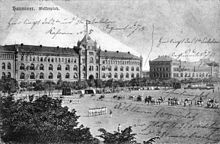Exercise
The word drill (lat. Exercere - practice) was earlier for practicing any learning object needed. For the soldiers' exercises in particular, an explanatory addition was initially necessary, e.g. B. "Exercise in arms"; this addition was later dropped.
The exercise of the military was once the training in the use of weapons and in the movement of closed detachments, a combat training appropriate to the tactical principles of the time, in which in closed battalion (as in the sense of a battle group) or company columns marched on the battlefield and both for defense the battle was also waged to attack. These rules and principles were set out in writing in the drill regulations . With the advancing development of modern warfare , the disintegration of formations forced by the increased weapon effect and the requirement of independently acting fighters, the drill as a formal movement on the battlefield became less important.
Adapted to the conditions of a modern technical army, the actual exercise, the formal service, has lost its importance for combat service. Even so, it is still considered indispensable in most armies of the world today, albeit to a very different extent. Psychological considerations certainly also play a role. In the original essence of drill, in the sense of " practice ", it has retained its value in the terms of combat and weapon training.
Exercise in today's sense is the practice of mechanical action processes that can only take place in a certain way that can no longer be considered for soldiers of all ranks. Examples are the course of action of creating full protection in the event of an NBC alarm or the elimination of a malfunction such as with the machine gun by sleeve jamming or the handling of weapons in general (dismantling, reassembling, etc.), but the term drill is used here .
In a narrower sense is now under drill in the Armed Forces of the formal service understood. The term drill service is used for this in the Austrian Armed Forces . The term train school is used in the Swiss Army .
See also
- Military salute
- Gun drill
- Drill team
- Exercise house of the Kaiser-Franz-Garde-Grenadier-Regiment No. 2
- Exercises
literature
- Otto Bleck, Wilhelm Müller-Loebnitz, Ernst Kabisch, Ulrich Schmidt, Edgar Röhricht , Walter Georg Lohmann, Alfred Wolf, Hermann von Wilamowitz-Moellendorff: The German Defense System in the Past and Present. Konradin-Verlag, 1936, p. 281.
- Herzoglich Pfalzzweybrückisches Exercierreglement , 1791 ( online )


